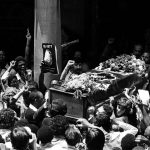Neil Aggett’s family hopes for answers
If a player can be found, a tape recording at the reopened inquest may reveal new information about the anti-apartheid activist’s death at the notorious John Vorster Square police station in 1982.…
Author:
21 January 2020

“INQUEST INTO THE DEATH OF THE LATE NEILHUDSONAGGETT” read the hastily printed, misspelt sign on the door of the stiflingly hot, Gremlins-in-the-air-conditioning courtroom of the Johannesburg high court on the morning of Monday 20 January.
The legal teams for the National Prosecuting Authority (NPA), the Aggett family and members of the former security police waited for Judge MA Makume to get proceedings under way. Aggett’s sister and only surviving direct family member, Jill Berger, sat next to his former friend and fellow activist Gavin Andersson. The family’s former junior attorney in the original 1982 inquest into Aggett’s death, David Dison, sat in the row in front of them, peering at his notes over spectacles nestled below his strikingly bushy eyebrows.
Behind Dison sat Elizabeth Floyd, Aggett’s partner at the time of his death. She was also detained as part of a raid on activists that began in late 1981, when members of the apartheid regime’s security forces tricked activist and former minister of health and public enterprises Barbara Hogan into handing over a list of names and contacts to a person she thought was an ANC contact.
Next to Aggett’s nephew, Stephen Aggett, sat former Truth and Reconciliation Commission (TRC) commissioner and head of the Foundation for Human Rights Yasmin Sooka, fanning herself in the heat. Imtiaz Cajee, the nephew of Ahmed Timol, sat at Sooka’s side. Timol was a Roodepoort teacher and activist who was the first person to die in detention at the then John Vorster Square police station in 1971, when he plunged 10 floors to his death during an interrogation. This was 11 years before Aggett was found hanging by a rope made from a kikoi attached to the bars of cell 209 in the same complex, in the early hours of the morning of 5 February 1982.
Related article:
Aggett was the 51st person to die in detention in South Africa since 1963, when then minister of justice Balthazar Johannes Vorster introduced the 90-day detention law as the first in a series of increasingly draconian measures intended to crack down, by whatever means necessary, on opposition to the apartheid regime. Aggett was also the fifth detainee to die at the police station named after the man whose laws had given almost unchecked powers to the security police.
Three more detainees would die there before Nelson Mandela was released from prison in 1990. These included Ernest Dipale, who died just months after Aggett. He was found hanged in his cell at John Vorster Square on 8 August 1982. No police station saw more deaths in detention than the place its survivors grimly referred to as Johannesburg’s “Blue Hotel” and whose name during the apartheid era became a byword for death, torture and what Hogan once described as the “reign of the mad forces”.
Further down the bench from Cajee, a lone man could be seen dressed in a T-shirt bearing the logo of the Food and Canning Workers’ Union of which Aggett had been the Transvaal secretary general when he died. Gauteng member of the executive council for education Panyaza Lesufi made a brief appearance in his flashy striped tie in ANC colours to listen, as he had done during the Timol inquest, to the opening arguments before hurrying off to address the surely many pressing requests for his time in the light of weekend revelations in the cases of two teenagers who died during school orientation.
No ordinary hearing
There may not have been much noise or fanfare in courtroom 8F or outside the high court precinct on Monday morning, but it was evident to anyone who cared to look at those assembled that this was no ordinary hearing. For a particular section of South African society whose lives had been deeply embroiled in the anti-apartheid struggle, the story of what happened to Neil Hudson Aggett is still one that needs urgent answers to unanswered questions and has implications for the nation’s ability to properly face the ugly ghosts of its violent past.
In 25 years of democracy and almost 17 years after the TRC handed its final report to the parliament of former president Thabo Mbeki in 2003, the only apartheid-era, death in detention case to receive a court hearing has been that of Timol. His family, like the Aggetts and many others still waiting for answers, fought long and hard using their own resources to force the government to reopen in 2017 the inquest into his death. Then, Judge Billy Mothle found that contrary to the findings of the original 1972 inquest into Timol’s death, the security police were directly responsible for his death.
Related article:
In his opening argument for the Aggett family, advocate Howard Varney – who also represented the Timol family in their inquest – told the court that: “It is the Aggett family’s firm belief that Neil was killed at the hands of the SB [Security Branch] officers, either directly or through unrelenting systematic torture, abuse and neglect, which pushed him to take his own life, for which the relevant Security Branch officers must be held accountable.”
It is also “nothing less than disgraceful that the Aggett family had to wait some 26 years before a post-apartheid government reopened the inquest”, Varney added. In that time Aggett’s parents, Aubrey and Joy, and his older brother Michael have died. His chief interrogators, Major Arthur Benoni Cronwright, the head of the security police at John Vorster Square at the time, and Lieutenant Stephan Whitehead have also died, Cronwright in 2012 and Whitehead last year, ironically in the week in which former justice minister Michael Masutha announced that the inquest would be reopened.
Neither Cronwright nor Whitehead applied to the TRC for amnesty for their role in Aggett’s detention and their secrets appear likely to disappear with them beyond the grave. However, Warrant Officer Frank Kgamanyane, the NPA investigator for the Priority Crimes Litigation Unit tasked with collecting evidence for the inquest, spoke of a recording made by former security police officer Paul Erasmus on a “Nagra spy machine”, a miniature audio tape recorder, that may contain a conversation with Whitehead about the Aggett case. At the moment, while the tape is in the possession of the NPA, Kgamanyane told the court that he had not managed to track down a machine capable of playing the recording.
Back to life
Erasmus will give testimony next month, but whether or not Whitehead’s voice makes a ghostly appearance remains to be seen. What is certain is that the witness list for the six weeks of the Aggett inquest will bring the medical doctor and trade union activist back to life through the memories of his sister, his former partner and the fellow activists and detainees who saw him over the 70 days of his detention at John Vorster Square. They include Hogan, Firoz Cachalia, Frank Chikane, Parmananthan Naidoo, Ismail Momoniat, Maurice Smithers and Keith Coleman.
As they did during the original inquest, the voices of these former detainees will paint a grim and desolate picture of what went on in the shadows of the interrogation offices on the notorious ninth and 10th floors of John Vorster Square during some of the darkest days of South Africa’s history.
It is on those floors that detainee deaths were brushed away with absurd claims by the security police that, as author and poet Chris van Wyk put it, they had “slipped on the ninth floor while washing … fell from a piece of soap while slipping … washed from the ninth floor while slipping … hung from a piece of soap while washing”. On the morning of 21 January the inquest will visit those very floors, with an in loco inspection of cell 209, where Aggett died, and the offices on the ninth and 10th floors where he was taken for interrogation.
Once again a ghost trapped in the edifice of what is now the Johannesburg Central Police station is stalking its corridors, clamouring to be heard and released, and forcing those who were there during the bad old days of John Vorster Square to relive terrifying experiences. Those experiences were undergone for the creation of a democratic dispensation built on the blood of Timol, Aggett and others. A dispensation that would now rather let sleeping ghosts lie but can no longer afford to ignore the plaintive and urgent cries for justice, answers and accountability from the ghosts of those who never managed to check out of the Blue Hotel.


